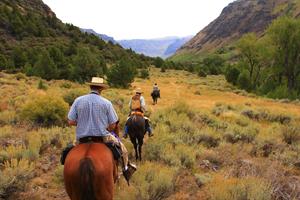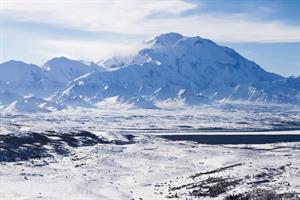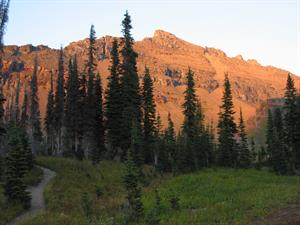Iowan Art Check paddled his canoe across Nina Moose Lake in northern Minnesota on the last night of his family’s canoe trip. His 10-year-old son Dean paddled in the bow, intent on fishing. Dean hadn’t yet caught a fish on this trip, despite the many efforts that he and sister Ella had made, and he was desperate to land one. Art and Dean paddled on, casting and trolling, trying one last time to top off Dean’s trip with a fish. Later, paddling up to their campsite, an ear-to-ear grin spread across Dean’s face as he hoisted up a stringer and showed his mother Kelly and his sister not only his father’s three-pound smallmouth bass but the walleye that Dean himself had finally reeled in.
Bill Cunningham watched a young bull elk through his rifle scope, only 50 yards away, as the elk slowly walked from a spruce thicket into a small clearing. The day before, he had backpacked his solo camp over the continental divide south of Glacier National Park in northwest Montana. The only suitable campsite he had found was right where the elk were, judging by the elk rubs and fresh scat. It snowed that first night, turning the rust colors of early fall to white. He had left camp before daybreak, and before long cut across fresh tracks — not of elk but of a grizzly. He quickly changed course and soon came across the trail of a lone bull elk that led him ever deeper into the darker timber. “I was close,” Bill later recalled. “I could smell him, and suddenly there he was, broadside at point blank range.” The “raghorn” bull was his, for a split second seemingly unaware of Bill’s presence. During that same split second, “I made the conscious decision to pass on the shot,” Bill says. Back at camp, sipping a cup of strong cowboy coffee, Bill reflected on his good fortune — not only at having experienced a wonderful fall hunt but also his easy path home: “Imagine having to pack out hundreds of pounds of elk meat on my back!”
A few years ago, professional backpacking guide Howie Wolke led a group through the wilds of northern Alaska’s Brooks Range during the early autumn caribou migration. “The tundra was a rainbow of autumn pelage. Fresh snow engulfed the peaks and periodically the valleys, too,” he later wrote. “Animals were everywhere, thousands of them, moving across valleys, through passes, over divides, atop ridges. Wolves chased caribou. A grizzly [feeding] on a carcass temporarily blocked our route through a narrow pass...I think that if I had 14 lifetimes, I’d never again experience anything quite so primeval, so simple and rudimentary, and so utterly and uncompromisingly wild.”
All three of these experiences were made possible because the areas in which they took place enjoy protection under the 1964 Wilderness Act, a landmark conservation law celebrating its 50th anniversary this year. That law provides special protection for these three places — the Boundary Waters Canoe Area Wilderness in Minnesota, Montana’s Bob Marshall Wilderness, and the Mollie Beattie Wilderness of the Arctic National Wildlife Refuge in Alaska — and many others across the country.
A Wilderness of History
A half-century ago, with the strong support of the Izaak Walton League, Congress passed and President Lyndon B. Johnson signed into law the 1964 Wilderness Act. This keystone conservation law provides the highest protection available for federal public lands, conserving important wildlife habitat and providing outstanding recreational opportunities for the American people, including hunting, fishing, and camping.
The League played a critical role in the creation of the Wilderness Act. In fact, since its earliest origins, the League has fought to protect wilderness areas. In 1923, for example, League founder Will Dilg and a group of League members and writers took a canoe trip in what is now called the Boundary Waters Canoe Area Wilderness (BWCAW) in Minnesota. Dilg pledged to the group and their 24-year-old guide, Sigurd F. Olson, that the organization would always fight to protect this flagship wilderness area — a pledge that remains fulfilled to this day.
The U.S. Forest Service, under prodding from agency staffer Aldo Leopold, first established a wilderness area in 1924 by administrative means within the Gila National Forest in New Mexico — a realm of mountain ranges, meadows, and rock-walled canyons that plunge to depths of more than a thousand feet. By the late 1930s, under the leadership of its director of recreation, Robert Marshall, the Forest Service had built a system of 74 administratively-designated wilderness areas on national forests that totaled 14.2 million acres. That system included the Gila and Boundary Waters wildernesses.
 However, conservationists knew that these administrative protections were weak. The League’s executive director, Kenneth Reid, noted in a 1939 article in Outdoor America, “There is no assurance that any one of them or all of them might not be abolished as they were created — by administrative decree. They exist by sufferance and administrative policy — not by law.” This recognition led the League and other conservationists to look for a way to more permanently protect these special places.
However, conservationists knew that these administrative protections were weak. The League’s executive director, Kenneth Reid, noted in a 1939 article in Outdoor America, “There is no assurance that any one of them or all of them might not be abolished as they were created — by administrative decree. They exist by sufferance and administrative policy — not by law.” This recognition led the League and other conservationists to look for a way to more permanently protect these special places.
Wilderness designation was viewed as critical for protecting an area’s wild and undeveloped character for the long term. While national parks and national forests provided some protection, for example, wilderness designation would prevent even parts of national parks or national forests from being developed at some point in the future for facilities such as visitor centers or new roads.
By the mid-1950s, conservation leaders launched a campaign for statutory wilderness protection in federal law. Led by Howard Zahniser of The Wilderness Society, the effort to pass the Wilderness Act through Congress took 8 long years, 18 different hearings, and a staggering 66 rewrites of the legislation. The League’s conservation director, Joe Penfold, was part of the inner cadre of conservationists who kept pushing the wilderness legislation past the many obstacles.
Finally, on September 3, 1964, President Johnson signed the Wilderness Act into law in a Rose Garden signing ceremony. As he signed the bill, President Johnson remarked that the wilderness law is “in the highest tradition of our heritage as conservators as well as users of America’s bountiful natural endowments. The Wilderness Bill preserves for our posterity, for all time to come, nine million acres of this vast continent in their original and unchanging beauty and wonder.”
The Wilderness Act
The law that LBJ signed brought instant wilderness designation to 54 areas that totaled 9.1 million acres — all managed by the U.S. Forest Service. Initially, no lands managed by other federal land agencies, such as the U.S. Fish and Wildlife Service or the National Park Service, were included in the National Wilderness Preservation System.
In addition to creating the wilderness system, the new law did many other things. For the first time, wilderness areas had federal statutory protections against road building, logging, mining, and construction of buildings or dams. The Wilderness Act also defined wilderness in one of the most poetic passages in all federal statutes: “A wilderness, in contrast with those areas where man and his own works dominate the landscape, is hereby recognized as an area where the earth and its community of life are untrammeled by man, where man himself is a visitor who does not remain.” Zahniser carefully chose the word “untrammeled” — which means unmanipulated or unconfined — so that wildernesses would remain free of human domination and manipulation.
But that doesn’t mean you can’t visit. Hundreds of thousands of people annually hunt, fish, camp, hike, and canoe through many wilderness areas. Young and old, able-bodied and with physical limitations, Americans love to visit their favorite wildernesses.
Growth of the Wilderness System
The 1964 law also set up a process by which new areas could be added to the wilderness system, but each new wilderness requires an Act of Congress. Although conservationists initially thought that this requirement was a terribly high hurdle, Stewart Brandborg of The Wilderness Society (who took over the organization after Howard Zahniser’s untimely death in 1964) saw this provision as an opportunity to build grassroots support for wilderness across the nation.
Brandborg, Penfold, and others did just that, and the results have been nothing short of stunning. From 54 areas and 9.1 million acres in just 13 states, the National Wilderness Preservation System has grown today to 758 areas totaling about 110 million acres in 44 states — a 12-fold acreage increase since 1964. All four primary federal land management agencies — the Forest Service, Fish and Wildlife Service, National Park Service, and Bureau of Land Management — are now stewards of wilderness.
Since 1964, more than 100 separate bills designating new wildernesses have passed Congress. Two specific examples of the growth of the wilderness system merit notice, due in part to League involvement and in part to their precedent-setting nature.
Boundary Waters: Minnesota’s BWCAW had been included in the 1964 law but with exceptions that allowed logging and motorboat use to continue within the canoe country, making it a wilderness in name but not necessarily in management. Controversies erupted in the 1970s over the area, and Congress again took up legislation dealing with the Boundary Waters. Minnesota Ike Miron “Bud” Heinselman chaired the Friends of the Boundary Waters Wilderness coalition and convinced Congress to pass a bitterly contested new BWCAW law in 1978 to give the area more complete wilderness protection. In removing the special BWCAW language from the Wilderness Act, the 1978 BWCAW law marked the only time the Wilderness Act has ever been amended. Today, the Boundary Waters Wilderness welcomes more than 250,000 visitors each year.
 Alaska: Throughout the 1970s, efforts were underway to protect the vast wilderness areas of Alaska. League members and staff actively participated in the Alaska Coalition, pushing Congress to pass a sweeping law to create new conservation areas such as national parks and wildlife refuges there. Also in the mix were new wilderness areas. Their efforts succeeded at the end of 1980, when President Jimmy Carter signed the Alaska National Interest Lands Conservation Act (ANILCA). With the stroke of Carter’s pen, 56 million acres of new wilderness were designated on federal public lands in Alaska, more than doubling the size of the National Wilderness Preservation System.
Alaska: Throughout the 1970s, efforts were underway to protect the vast wilderness areas of Alaska. League members and staff actively participated in the Alaska Coalition, pushing Congress to pass a sweeping law to create new conservation areas such as national parks and wildlife refuges there. Also in the mix were new wilderness areas. Their efforts succeeded at the end of 1980, when President Jimmy Carter signed the Alaska National Interest Lands Conservation Act (ANILCA). With the stroke of Carter’s pen, 56 million acres of new wilderness were designated on federal public lands in Alaska, more than doubling the size of the National Wilderness Preservation System.
Building of the wilderness system continues to this day. In March 2014, Congress created the newest addition, the 32,557-acre Sleeping Bear Dunes Wilderness in Michigan, which includes miles of beach and spectacular sand dunes rising hundreds of feet above the eastern shore of Lake Michigan.
Today’s National Wilderness Preservation System contains many of the crown jewels of America’s public lands. The smallest is the tiny 5.5-acre Pelican Island Wilderness in Florida, first protected by President Theodore Roosevelt in 1903 as a bird sanctuary. The largest is the nearly 10 million acre Wrangell-St. Elias Wilderness in Alaska.
Americans can visit a wide variety of wilderness ecosystems. Not only are there the classic mountain wildernesses of the Rockies, the Cascades, and the Sierra Nevada but also watery wildernesses such as Florida’s Everglades, nearly 1.3 million acres of which is protected as the Marjory Stoneman Douglas Wilderness — the largest wilderness area east of the Rockies, one-third of which is under water.
Remnants of prairie grasslands are protected in places including the Theodore Roosevelt Wilderness in North Dakota and South Dakota’s Badlands Wilderness. In the Midwest, the East, and the South, wilderness areas are generally smaller but no less accessible. People enjoy horseback riding in the Lusk Creek Wilderness in southern Illinois, for example, or hiking and hunting in the rugged wildernesses along the Appalachian Mountains, including West Virginia’s Cranberry Wilderness and the 139,000 acres of wilderness in the George Washington and Jefferson National Forests in Virginia.
The economic value of recreational trips to the National Wilderness Preservation System is estimated by scholars and scientists to be $465.1 million annually. This figure does not include the value of environmental benefits provided by these wilderness areas, including clean drinking water and flood protection, or their scientific value. Wilderness designation also enhances property values in communities located near wilderness areas, according to a 2004 policy brief from The Wilderness Society.
In addition to providing a variety of wild landscapes to visit and recreate in, the National Wilderness Preservation System also protects a rich variety of ecological biodiversity and landscape types for future generations.
Looking Ahead
Despite the success of the Wilderness Act and the popularity of many of the areas in the National Wilderness Preservation System, wilderness in the United States today faces significant challenges, including:
- Insufficient Funding and Oversight: Funding for federal agencies to effectively manage wilderness needs to be increased. Moreover, some wilderness managers in the federal agencies need to place greater priority on managing those lands to protect inherent wilderness values, including solitude and quiet recreation.
- Gridlock in Congress: Congress continues to be bitterly polarized over many issues, including wilderness. There are other areas that deserve wilderness protection — areas where local citizens have come together to support wilderness designation but Congress cannot seem to act on most proposals.
- Special Provisions: Many new wilderness designation bills contain “special provisions” providing exemptions for activities not normally allowed in wilderness, including motor vehicle use. The collective impact of these special provisions is an erosion of national wilderness standards.
- Increasing Motorization and Mechanization: In the past, federal agencies took great pride in managing wildernesses without machines, including using pack stock for transportation and cross-cut saws rather than chain saws. Now some wilderness managers rely increasingly on motorized vehicles — including helicopters — to quickly do a job, regardless of the negative impacts on the area’s wilderness character, where natural quiet and solitude are fundamental.
 League members and other conservationists can have a positive impact on all of these challenges. We can express our support to members of Congress for additional funding for wilderness. We can tell local wilderness managers that we support managing and protecting wildernesses to the highest standards possible, without the increasing motorization and mechanization that some managers employ. League members can also speak out against special provisions that weaken the national standards for wildernesses. We can talk up the values of true wilderness to our friends and colleagues. And we can continue to visit wilderness areas (and bring newcomers along) to experience the marvelous values that they offer.
League members and other conservationists can have a positive impact on all of these challenges. We can express our support to members of Congress for additional funding for wilderness. We can tell local wilderness managers that we support managing and protecting wildernesses to the highest standards possible, without the increasing motorization and mechanization that some managers employ. League members can also speak out against special provisions that weaken the national standards for wildernesses. We can talk up the values of true wilderness to our friends and colleagues. And we can continue to visit wilderness areas (and bring newcomers along) to experience the marvelous values that they offer.
Despite the challenges, League members should remember with pride the history of wilderness conservation and the League’s more than 90 years of work to protect some of the most spectacular places in America. We helped protect unique wild landscapes that provide rich and meaningful opportunities that many Americans — including Art Check’s family, Bill Cunningham, and Howie Wolke — continue to experience. And we can pass on to future generations what the Wilderness Act calls “an enduring resource of wilderness.”